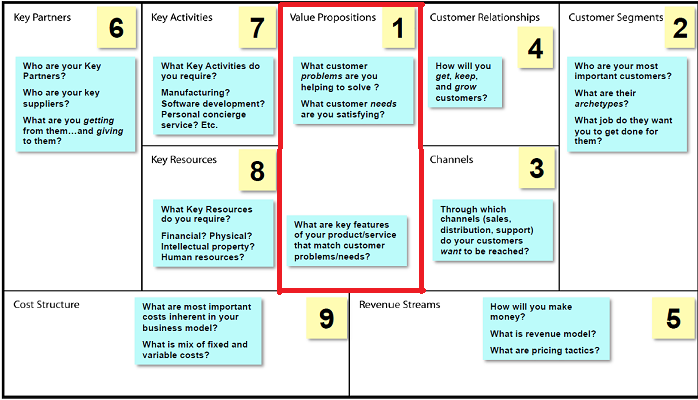
The question I like to ask my clients and students who are starting a company is: “why would I buy their product or service instead of the company’s next door?” They normally come back at me with the types of features they have, or the coolness of their product. The Value Proposition is asking what pains and gains I will receive from using your product/service instead of the other company’s. Let’s look at what that means.
What is it you are building, and for whom are you building it?
What pains are you removing, or what gains you are creating?
Pain Killer. What are you going to reduce or eliminate for the customer? Is it wasted time, cost reduction, emotional frustration, or risk removal?
Gain Creator (The Solution). How do you create benefits for the customer? Is it through exceeding their expectations and desires, or will they be surprised by the ease of the solution?
Once you have gotten out of the building and interviewed hundreds of potential clients in your customer-discovery phase of this process, you then come back to the lab and design a Minimal Viable Product (MVP) from what you learned. What is the Minimum Viable Product? It is the smallest feature set you can create to show the potential client that it would solve their pains or create gains. This is where I see clients and students go off the rail, especially engineers. They come up with a 50-feature set of ideas, and have no clear vision of what the customer wants or desires. This will only confuse the potential client and drive them away. You need to make the MVP as simple as possible to understand. Remember, you will be returning back to the client with your MVP, saying, “This is what I’ve created to solve your problem. Is this what you were talking about?” Other features will add on after launching, depending upon the customer feedback.
There are two types of MVPs — Physical and Web/Mobile. Let’s look at each:
Physical. This is a product that will be sold through a direct sales channel, so you will need something that the customer can touch or feel. If not, I have my students go out with a power-point slide deck. This will test the understanding of the problem and solution. It will also help you figure out the minimum features the customer desires.
Web/Mobile. You need to start with a low-fidelity website. This means you need either a wire frame, or a power-point mockup of what you are creating. Remember to keep it simple. This is so the customer can understand what you are trying to solve or create. I would advise that you get a high-fidelity feature a few weeks after your customer interviews, which would include a more detailed webpage and an actual back end that works. This will help you develop something the customer wants and desires, without trying to figure it out yourself and wasting a lot of time while doing so. I love this process, because all you need to do is just ask the client, and they will tell you what they want!
What most start-ups don’t understand is that it’s not about your idea or product, but about solving a problem or a need for a customer. So, what does that mean, and what is the difference between a problem and a need?
Problem. This is solving an accounting problem or a company systems problem.
Need. This is universal, and is therefore wanted by the billions of people on the planet. Great examples of this are communications, entertainment, and even love. EHarmony tapped into this like no other company. Apple also took the iPhone and turned it from a problem of communication to a need that resulted in people wanting a new one every year.
The Value Proposition works hand-in-hand with the Customer Segment part of the BMC, which I will be writing about next week. When a start-up can connect the two (Value Proposition and Customer Segment), we call that a Product Market Fit. This answers the question, “Is what I’m building needed, wanted, or desired by the customer?” The great news about the Business Model Canvas (BMC) is that you can iterate (make small changes) or pivot (go in a totally different direction) between the Value Proposition and the Customer Segment during the Customer Discovery stage until you get it right. When this is accomplished by a start-up, the chances of success increase significantly.
Most start-ups only look at what their actual product or service Value Proposition will bring to the client. I ask my clients and students to look at the whole package to be delivered to the customer. Here are a few questions you need to ask yourself about your product or service:
Product
What are the parts of your value proposition? Manufactured goods, commodities from other lands, etc.?
What are the entanglement parts of your value proposition? Perhaps copyrights, the licensing, or something else?
Are there financial parts, like insurance you offer, financial guarantees, and so forth?
Is it digital, like MP3 files or e books?
Service
Which core services are part of your Value Proposition? Is it consulting, a haircut, investment, or advice?
Which presale will you offer? Is it to help the client find a solution, financing, free delivery?
What after-sale services will you provide? Is it free maintenance, disposal of product, etc.?
The Value Proposition is the part of your product and service that states exactly why the client would rather buy from you than from your competitor. It is the part that describes what pains you will be removing and what gains you will be adding.
For more information about starting a company or new product development, please feel free to contact me at dmuir@muirandassociates.net
Source:
Blanks, S. (n.d.). (2015, November 13). Business Model Canvas. Udacity. Retrieved from www.udacity.com
Investopedia. (2015, November 13). Value Proposition. Investopedia. Retrieved from http://www.investopedia.com/terms/v/valueproposition.asp

